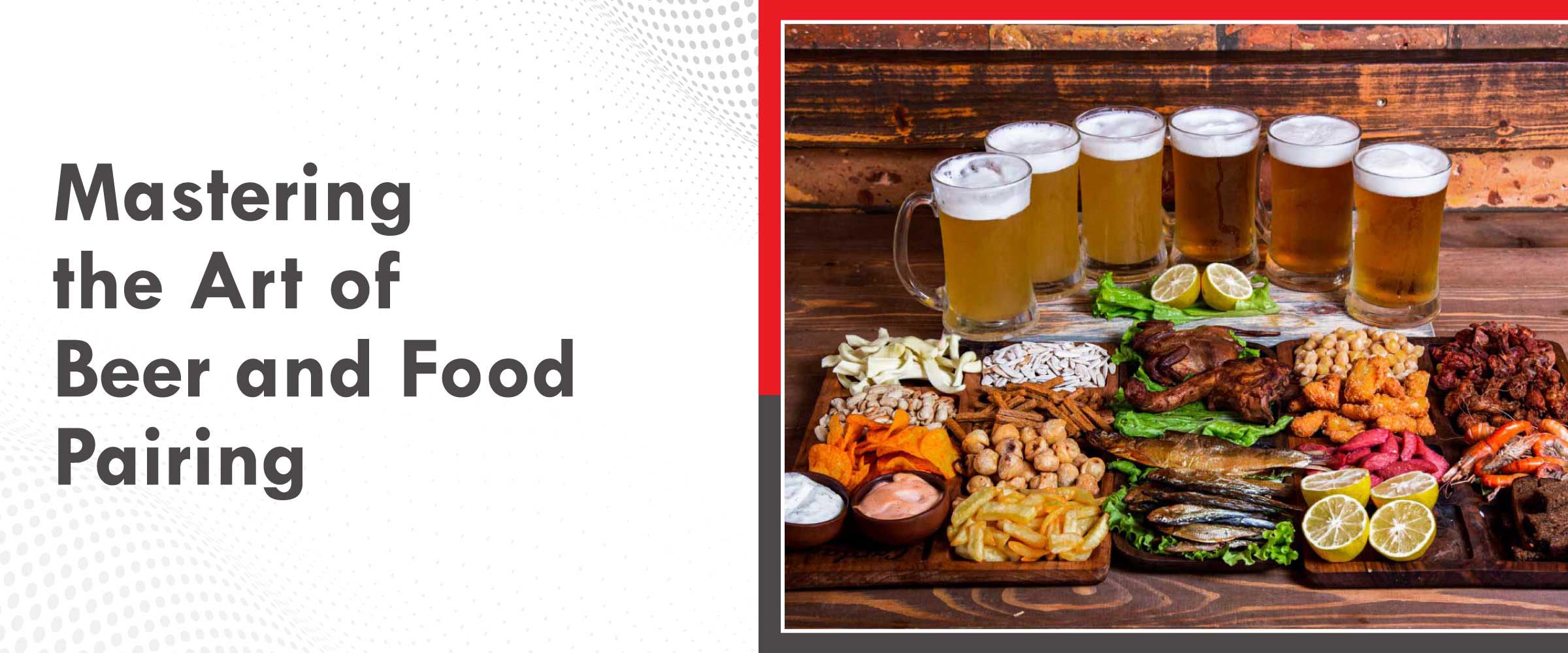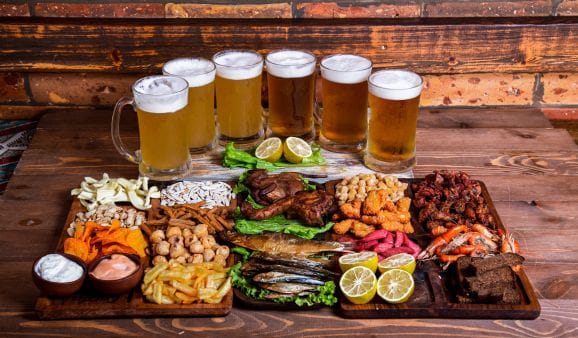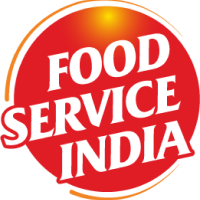
The Complete Guide: Master the Art of Pairing Beer with Food (Styles, Strategy, and Menu Design)
India’s beer scene has undergone a revolution in the last few years, and beer aficionados are now on the lookout for more than just a chilled pint.
They want exciting and share-worthy experiences that turn a simple meal into a memorable story they can tell their friends.
That’s where a curated beer pairing menu comes in.
Beer and food pairings are not just about taste; they’re about striking the right balance. The right pairing can turn an everyday dish in your menu into something more eventful. It will also make your menu feel more intentional.
As a restaurant, bar, and brewpub owner, this can translate directly into stronger sales figures and higher visitor engagement. The right beer food pairings will increase your average ticket size and drive more repeat orders.
In this beer and food pairing guide, we’ll walk you through the fundamentals of how to pair beer with food with practical examples and simple tips to get you started with your own beer-friendly menu.
A] The Basics of Food and Beer Pairing
The art of pairing food and beer comes down to understanding two simple principles: complementary and contrasting flavour profiles. Once you understand these two, you can make any meal feel thoughtfully curated.
1. Complementary Pairings
The main idea here is to match similar flavour profiles so that both your chosen food and beer option enhance each other.
- Match the Weight and Body: A heavy dish will pair well with a more full-bodied beer, while for lighter meals you should choose a light-bodied, refreshing beer, such as a pilsner or a pale lager. Think paneer tikka with a malty brown ale or a quinoa salad with a crisp lager.
- Balance Intensity: For strong, aromatic foods you should choose beers that can cut through the richness and provide a similar level of flavour concentration. You could pair a spicy curry with a hoppy IPA to allow the bitterness of the hops to compete with and balance the dish’s spicy, aromatic flavours.
- Find Shared Notes: You should always look for overlapping flavours. For example, a chocolate tart with hints of berry pairs beautifully with a cherry stout or a fruited sour.
2. Contrasting Pairings
The opposites attract principle applies to almost all aspects of life, none more so than in food and beer pairing, where opposing notes often combine to create palate-cleansing harmony.
- Sweet vs. Salty: You can pair a rich, sweet Belgian Tripel with masala peanuts or salted papad to allow the beer’s sweetness to cut through the saltiness, making both flavours pop.
- Bitter vs. Sweet: A coffee stout will perfectly cut through a gulab jamun cheesecake or a salted caramel kulfi with just the right amount of bitterness.
- Spicy vs. Sweet: For menu items that have fiery Indian flavours like chilli chicken or paneer tikkas, you can opt to pair them with a fruity wheat beer or witbier, as the sweetness helps to cool the heat and balance the chili oils.
- Rich vs. Crisp: The combination of carbonation and acidity will refresh the palate of your customers. You should try pairing a tandoori pomfret or butter garlic prawns with a bright saison or pale lager.
B] Understanding Beer Styles and Their Core Pairing Notes
If you can understand what makes each beer style distinct, it will help you create better pairing combinations by knowing exactly which flavours to match or contrast.
Every beer has its own ABV (alcohol level), IBU (bitterness), carbonation, and flavour range, and each factor can affect the overall balance of the pairing combination.
1. Lager
Lagers are clean and refreshing. They are low on bitterness and pair well with salads, fried appetisers and grilled seafood.
2. Pale Ale
A pale ale has a malty and mildly bitter flavour profile. You can pair them with roasted meats or spicy wraps to use the bitterness as a palate cleanser.
3. Wheat Beer (Hefeweizen)
Wheat beers are slightly sweet and fruity, often accompanied by a note of clove or banana. Citrusy dishes like lemon butter prawns or feta-topped salad can be the perfect pairing option for wheat beer on your menu.
4. India Pale Ale (IPA)
IPAs have strong hoppy flavours accompanied by a distinct bitter edge. You can pair them with smoky barbecue plates, grilled tandoori kebabs, or spicy wings seasoned with dry rubs, spicy marinades or seasoning powders, as the bitterness of the beer will bring out the rich flavour profiles of the dish.
5. Stout or Porter
A stout beer will have creamy and roasted flavour notes. You should ideally pair them with dessert items in your menu like chocolate mousse or brownies, as the deep flavours of coffee and chocolate bring out the similar roasted and malty characteristics in the beer.
By properly understanding the right beer profiles, you can confidently mix and match textures, sweetness levels, and bitterness to design pairings that create new flavours and maximise customer satisfaction.
C] Top 5 Food Pairings That Always Work (and Why)
You don’t have to start with a long list of experimental combinations. Some classic pairings never miss because they work well every time. Here are a few to try on your next menu update:
1. Flint Eye Lager with Fish and Chips
A flint eye lager will have a light and crisp texture that can perfectly cut through the fried texture of fish and chips. The carbonation will also reduce the oiliness of the deep-fried fish, and your customers will find every bite to be lighter and cleaner.
2. Greene IPA or Level Head IPA with Spicy Peri-Peri Wings
Hops in a Greene IPA or Level Head IPA can balance spicy flavour profiles perfectly. The slight bitterness from an IPA can also cool down the heat from tandoori or peri-peri wings while amplifying the smoky edge.
3. Wheat Beer with a Cheese Platter
You can perfectly complement the fruity and slightly sweet profile of a wheat beer with mild cheeses like brie or gouda. It can also pair well with sharper options in your cheese platter, such as cheddar, without overpowering them.
4. Stout with a Chocolate Dessert
Dark beers like stout or porter can pair naturally with chocolate, as their roasted notes blend perfectly with cocoa’s richness and create an almost velvety, mocha-like finish.
5. Pale Ale with Tandoori Chicken
A pale ale’s subtle malt sweetness and balanced hops blend well with charred spices to accentuate the smoky flavours of the tandoori chicken without dulling the masala.
D] How to Build a Simple Beer Pairing Menu
You don’t have to uproot your current menu structure to build a new beer food pairing chart or menu. Think of this as your own beer and food pairing chart, where you match your best-selling dishes with beers that enhance their flavour profile.
Here’s how you can go about building your own beer and food pairing menu:
1. Choose a Balanced Beer Range
Ideally, your beer range should include pale ale, lager, wheat beer, stout, and IPA. This mix of beers will cover the full spectrum, from light-bodied and mild to dark-colored and bold. You should also look to include a low-or alcohol-free option to ensure that your menu is modern and inclusive.
2. Pair Beer Styles with Your Most Popular Dishes
Choose beers that either perfectly complement or contrast with your chosen food dishes. For example, you could pair a fruity wheat beer with salads topped with citrus dressings. Or you could contrast a hoppy IPA with a more spicy flavour profile, like buffalo wings.
3. Keep it Fresh
You should adjust your suggested beer pairings to reflect seasonal changes. Your summer menus can feature more grilled meats with lighter beers, while your winter menus should include roasted meats with richer brews. Promoting monthly specials is also a great way to introduce new pairings and drive repeat visits.
The part that you’ll probably love the most is that you don’t have to heavily promote your new beer pairing menu. You can just include them in special menu cards, chalkboards or through your social media handles.
E] Holiday and Festive Pairing Ideas for Your Beer Pairing Menu
Festive seasons are when your patrons are most likely to try new flavours, and that’s also the best time to refresh your beer pairings. You can create quick, high-impact pairings that tie into seasonal menus or themed specials.
1. Match the Mood for the Season
For your summer menus, you should include more light and citrusy beer options. The cooler months call for the inclusion of richer brews in your pairing menu. For example, a crisp wheat beer will pair beautifully with a festive sweet like saffron pannacotta (check out the recipe here) or other citrus-based dessert options in your menu, as the fruity notes and light body of the beer balance perfectly with the sugar.
2. Go Bold for Grills and Spice
Smoky tandoori dishes should take center stage during winter feasts. You should look to pair spicy starters like tandoori wings platters with a bold IPA, as the hops will cut through the spice and smoke and leave a clean finish that will keep your guests coming back for more.
3. Think Beyond the Main Course
Use beer pairings across your entire menu, including appetisers, mains, and desserts. A spiced stout with plum pudding, or a pale lager with festive finger foods, can make your holiday menu feel more curated. Your goal with the festive pairing menus should not be restricted to merely overhauling your offerings or to just adding pairings but to significantly elevate the guest experience and increase the average check size.
Seasonal menu updates like these will give your regular customers something new to look forward to and make your festive promotions stand out.
F] Menu Design, Staff Training, and Promotion
If you want to make your new beer pairing menu a success, then you need team buy-in and greater visibility. Here’s how you can go about achieving that:
1. Menu Design
Recommend beer pairings below the food description in your menu. Or you could highlight them with colour codes or icons so that it becomes easy for your patrons to connect the two.
2. Train Your Team
When you come up with new pairings, host quick tastings to give your front-of-the-house staff firsthand flavour knowledge and the language needed to sell them effectively. If they can pull off phrases like “this IPA helps round out the spice” with confidence, they will seem knowledgeable, and your visitors are more likely to try the suggested pairing.
3. Promote Smartly
You can use digital menus, chalkboards, and social media to introduce new pairings. You could also create concepts around it like “Perfect Pair” and promote it on your social media channels. Such themed concepts can help build the right buzz around the highlighted pairings and also encourage your customers to post on social media with a pairing hashtag.
Conclusion:
Elevate your visitors’ dining experience by crafting a creative beer pairing menu. It’s a great way to grow customer engagement and position your establishment as a thoughtful culinary destination.
Whether you’re a HoReCa product manufacturer, a restaurant partner, or one of India’s leading food product distributors, by designing thoughtful pairings, you can ensure stronger brand recall and deeper customer trust.
Once you get to grips with the basics of flavour intensity, balance, and beer styles, you will feel more confident to experiment with new combinations and truly make the pairing menu your own.
Whichever option you decide to include in your pairing menu, whether it’s a rich craft or stout beer with a dessert or spicy tandoori starters with a light lager, each pairing option should tell a small story on your menu. Over time, these thoughtful touches lead to higher repeat visits and stronger word-of-mouth for your brand.
Once your guests realise how well your food and beer work together, they won’t just come back; they will also enthusiastically bring their friends over to discover the difference.





